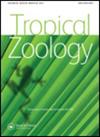巴西棘棘鱼的形态和两性二态性
IF 0.7
4区 生物学
Q4 ZOOLOGY
引用次数: 3
摘要
体型是研究物种生态、繁殖、进化和发育的重要参数,也是了解物种间的分类学关系和建立个体体型与形态关系的重要依据。研究了巴西棘龟(Acanthochelys spixii)种群在体型特征、性别二态性方面的差异,并描述了这些种群的性别比例。文中还介绍了这些种群的大小类别。我们对86名成年人进行了抽样调查(16名在米纳斯吉拉斯州(MG), 70名在南德州(RS))。两个采样区的性别比例均为1:1。雌性比雄性大,RS比MG大。后叶宽度(PLW)被认为是每个状态下标本线性判别分析中最重要的性别变量。两个变量PLW和最大甲壳宽度共同区分了四组(MG和RS中的雄性和雌性),准确率为77%。总体而言,居住在纬度较高、温度较低的最南端人口中,男性和女性的大多数身体尺寸都更大。性别大小二态性方面,MG组女性的PLW大于男性,RS组所有变量均为二态,总体上女性大于男性。本文章由计算机程序翻译,如有差异,请以英文原文为准。
Morphology and sexual dimorphism of Acanthochelys spixii (Testudines, Chelidae) in Brazil
Body size is an important parameter for ecology, reproduction, evolution, and development of animal species, besides understanding their taxonomic relationships and to establishing the relationships between individual size and shape. We evaluated the variation in body size traits, sexual dimorphism in populations of a turtle species Acanthochelys spixii across its distribution in Brazil and we described sex ratio in those populations. Description of the size-classes on these populations was also provided. We sampled 86 adults (16 in Minas Gerais (MG) and 70 in Rio Grande do Sul (RS)). The sex ratio was 1:1 in both sampling areas. Females were larger than males, and specimens from RS were larger than those from MG. The posterior-lobe width (PLW) was deemed the most significant sexing variable in a linear discriminant analysis of specimens within each state. Two variables, PLW and maximum carapace width, together distinguished the four groups (males and females in MG and RS) with 77% accuracy. Overall, most body measures were larger for both males and females in the southernmost population, inhabiting higher latitudes and lower temperatures. Regarding sexual size dimorphism, females had larger PLW than males in MG, and all variables were dimorphic in RS, in general females being larger than males.
求助全文
通过发布文献求助,成功后即可免费获取论文全文。
去求助
来源期刊

Tropical Zoology
生物-动物学
CiteScore
2.50
自引率
0.00%
发文量
1
审稿时长
>12 weeks
期刊介绍:
Tropical Zoology is an international zoological journal publishing original papers in the field of systematics, biogeography, phylogeny, ecology and conservation of all terrestrial and aquatic animal Phyla from tropical and subtropical areas.
Only papers with new information, high quality and broad interest are considered. Single species description and checklists are not normally accepted. Review papers are welcome. The journal is owned by the Istituto di Ricerca sugli Ecosistemi Terrestri of the Consiglio Nazionale delle Ricerche, Florence, Italy (CNR-IRET) who performs research into the structure and functioning of aquatic and terrestrial ecosystems, focusing in particular on anthropogenic pressure and global change. The knowledge amassed forms the scientific basis for identifying the most appropriate protective and corrective interventions, and provides support for the bodies entrusted with formulating policies for environmental protection and recovery.
 求助内容:
求助内容: 应助结果提醒方式:
应助结果提醒方式:


